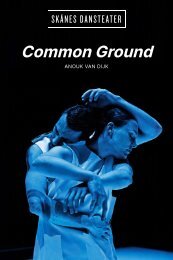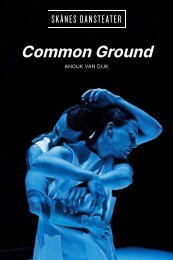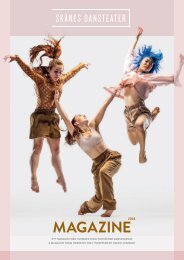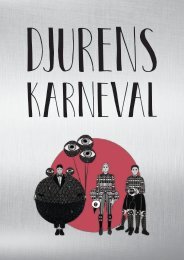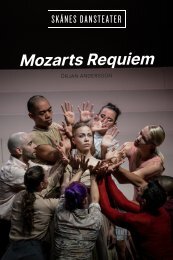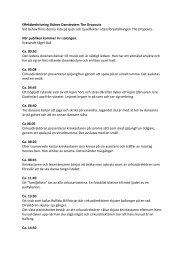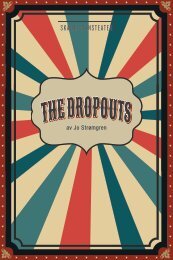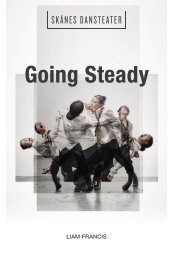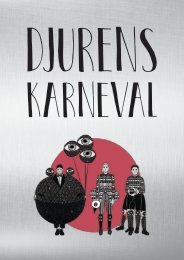Skånes Dansteater Magazine 2022
Skånes Dansteaters magasin om dansen, föreställningarna, mötena och konstnärerna som väntar på Sveriges enda fristående dansinstitution. Skånes Dansteater's Magazine 2022 about the dance, the performances, the artists, the encounters and the artists we are hosting during 2022.
Skånes Dansteaters magasin om dansen, föreställningarna, mötena och konstnärerna som väntar på Sveriges enda fristående dansinstitution.
Skånes Dansteater's Magazine 2022 about the dance, the performances, the artists, the encounters and the artists we are hosting during 2022.
You also want an ePaper? Increase the reach of your titles
YUMPU automatically turns print PDFs into web optimized ePapers that Google loves.
MAGAZINE <strong>2022</strong><br />
ZERO-ZERO, FRANZÉN/NUUTINEN<br />
‘I have a very aesthetic eye, but there must be<br />
a reason for the movement, the dance, to exist,<br />
more than just its beauty.ʼ<br />
34 35<br />
for Skånes <strong>Dansteater</strong>, Zero-Zero, in autumn <strong>2022</strong>.<br />
She told me more about her choreographic style. ‘I have<br />
been performing in a black box my whole life so there<br />
was a time when I enjoyed bringing dance to different<br />
environments. I wanted the body to meet and to be affected<br />
by different surfaces. That brought me to the world of film.<br />
This process culminated in a multi-disciplinary production<br />
called IRIS in which we integrated six dance short films<br />
with live performers. Although the process was incredibly<br />
rewarding, I have now returned to the black box and enjoy<br />
the challenges it offers.<br />
’In Skånes <strong>Dansteater</strong> it is going to be a very black box.<br />
In Zero-Zero we explore the edges of perception and<br />
how we construct meaning from the small fragments of<br />
information we see and hear.’<br />
’Together with my team we always think what we would<br />
like to offer the audience, what is important to us, and then<br />
the content grows from there. I think in a visual way and<br />
first imagine an image that grows into a scene or an entire<br />
piece. Over the last five years my focus has been on the<br />
senses. They are all naturally present in each work, but<br />
we then put one under the magnifying glass and make<br />
it the focus of that work. We will also use concepts of<br />
vision and touch in Zero-Zero. I am really fortunate at the<br />
moment to collaborate with Jarkko Lehmus, my husband,<br />
who is the dramaturg, Joonas Tikkanen for scenography<br />
and light design, and Tuomas Norvio, who is creating the<br />
sound identity. Sound is a big deal for me; I need to have<br />
an intuitive connection with it. Tuomas is in the studio<br />
creating with us and I haven’t used readymade music in<br />
years. It’s both a challenge and a treat! They are my team<br />
for Zero-Zero. We share the courage to take risks and it’s<br />
important we play for high stakes.’<br />
Speaking about her creative process, Nuutinen notes that the<br />
actual physicality, the movement language, was almost the<br />
last part that came into play. ‘Together, we start the dialogue<br />
that builds to feed the concept. When the parameters are in<br />
place, I will know the themes we are tackling, the visual world<br />
on the stage and a bit about the sound identity Tuomas has<br />
created. I then go into the studio and there I ask myself, ‘How<br />
does the space and the theme make me move?’ I also like to<br />
interview people from outside the dance world. I ask a few<br />
questions then listen to find the shared ideas. So even though<br />
the work might be abstract it still has an attachment to the<br />
world around me and that feels good.’<br />
The dancers at Skånes <strong>Dansteater</strong> are used to working<br />
with many different choreographers in many different<br />
styles and are adept at being part of the creative process.<br />
‘When I work with a company like Skånes <strong>Dansteater</strong>, I<br />
want to work with the essence of their movement talents.<br />
When dancers are familiar with improvisation, I give them<br />
task-based movement material to work on, as well as<br />
giving steps myself. When I work with a classical repertoire<br />
company which has a different working practice and might<br />
have less time for the creation, I use a different toolbox. I<br />
might then prepare every single movement before I work<br />
with the dancers. I see a shift happening, but traditionally<br />
the classical training does not give much space for selfdriven<br />
creativity. I think it also has to do with curiosity and<br />
courage, that you dare to suggest something of your own,<br />
and you dare to make a decision.’<br />
‘Choreography can be thought of as writing in movement.<br />
So, I am particular about what we write. What do those<br />
movements say? How does the viewer see them? What<br />
feeling does it arouse? I create a kind of arc and write what<br />
happens in that arc, then we improvise with the dancers.<br />
It is important to me to be present with the dancers for the<br />
morning class where we do exercises that feed my movement<br />
world. That is a really important part of the creative process. I<br />
want to challenge the dancers and awaken their imagination.<br />
Multi-dimensional movement interests me, and also fine<br />
detail. I have a very aesthetic eye, but there must be a reason<br />
for the movement, the dance, to exist, more than just its<br />
beauty.’<br />
How were you affected by the pandemic? ‘My personal<br />
experience was that I really needed to get out after the lockdown.<br />
When the museums opened, I went immediately<br />
because I needed to be questioned, to be affected, to dive<br />
into another person’s imagination. But on the positive<br />
side, the pause was good. It was a chance to refocus on our<br />
strategic planning; I felt more strongly why I wanted to do<br />
this and why it is important. Also, to think of how we can<br />
find more sustainable ways of creating art. We need art to<br />
open up our imagination, challenge us intellectually and<br />
touch us emotionally.’<br />
SKÅNES DANSTEATER





